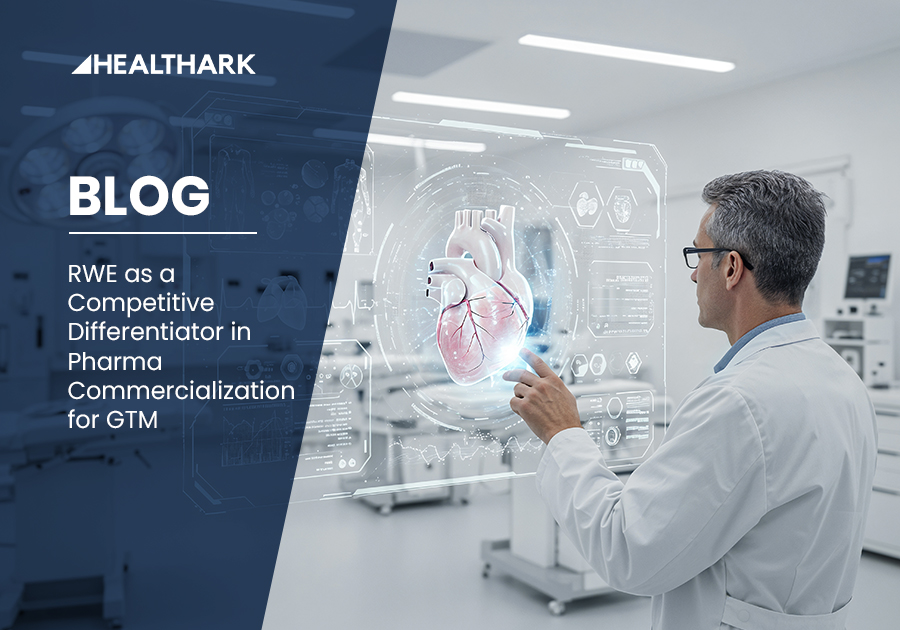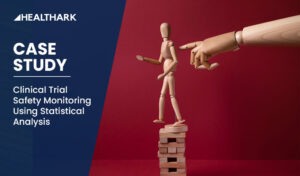Artificial Intelligence (AI), which at one point of time was stuff of science fiction has now become our new reality, ever since the global release of Large Language Models (LLMs) like ChatGPT, Gemini and Deepseek. While most are familiar with AI, fewer are aware of Machine Learning (ML), a subset of AI that deals with helping computers understand and learn from data without being explicitly programmed.
ML has essentially been integrated into every industry, ranging from the military to smartphone cameras. It is therefore not surprising that ML techniques are being used in healthcare to accurately diagnose cancer in patients and even help predict onset of cancer. ML can analyze vast datasets, such as Electronic Medical Records (EMRs), to detect patterns, anomalies, and diseases with radiologist-like precision. ML streamlines clinical trials by identifying ideal participants, optimizing sample sizes, and reducing errors through real-time data access. By combining personal health data with predictive models, ML delivers dynamic and efficient therapies, improving outcomes and quality of life globally while addressing challenges like radiologist shortages and trial inefficiencies.
This article is meant to explore and understand the basics of ML and its applications in healthcare.
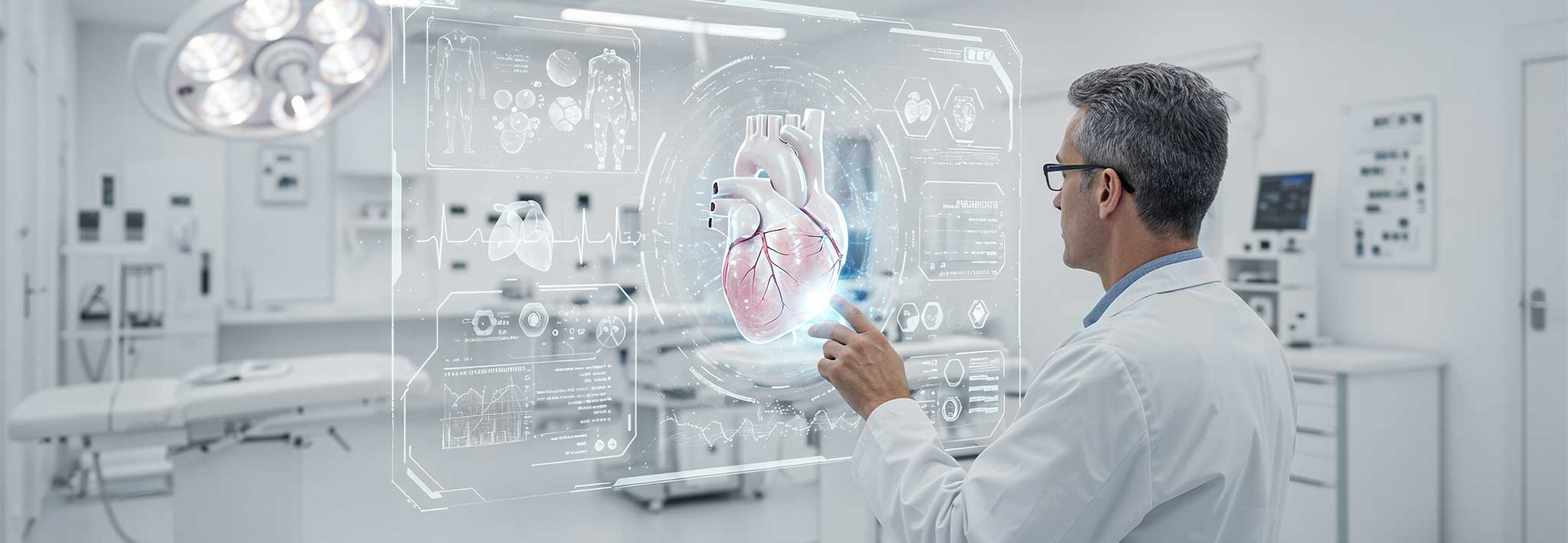
Data Trends and Market Overview
Before we dive into the basics, let’s talk numbers to understand the influence of Artificial Intelligence in the world. AI in the healthcare market is experiencing exponential growth in terms of market size, with projections indicating an increase from $39 billion in 2025 to $504 billion by 2032, at a compound annual growth rate (CAGR) of 44.0%.
North America dominated the market in 2024 with a 49.29% share, driven by advanced healthcare infrastructure and significant investment in AI research. In 2025, several key trends are emerging: clinical model management is increasingly adopting ML operations, multimodal AI is being utilized to leverage diverse data sources, translational research is accelerating, and virtualized education is becoming prominent for training purposes.
Lets take a look at how diseases are diagnosed using ML and how you could do it yourself.
ML Pipeline for Disease Diagnosis
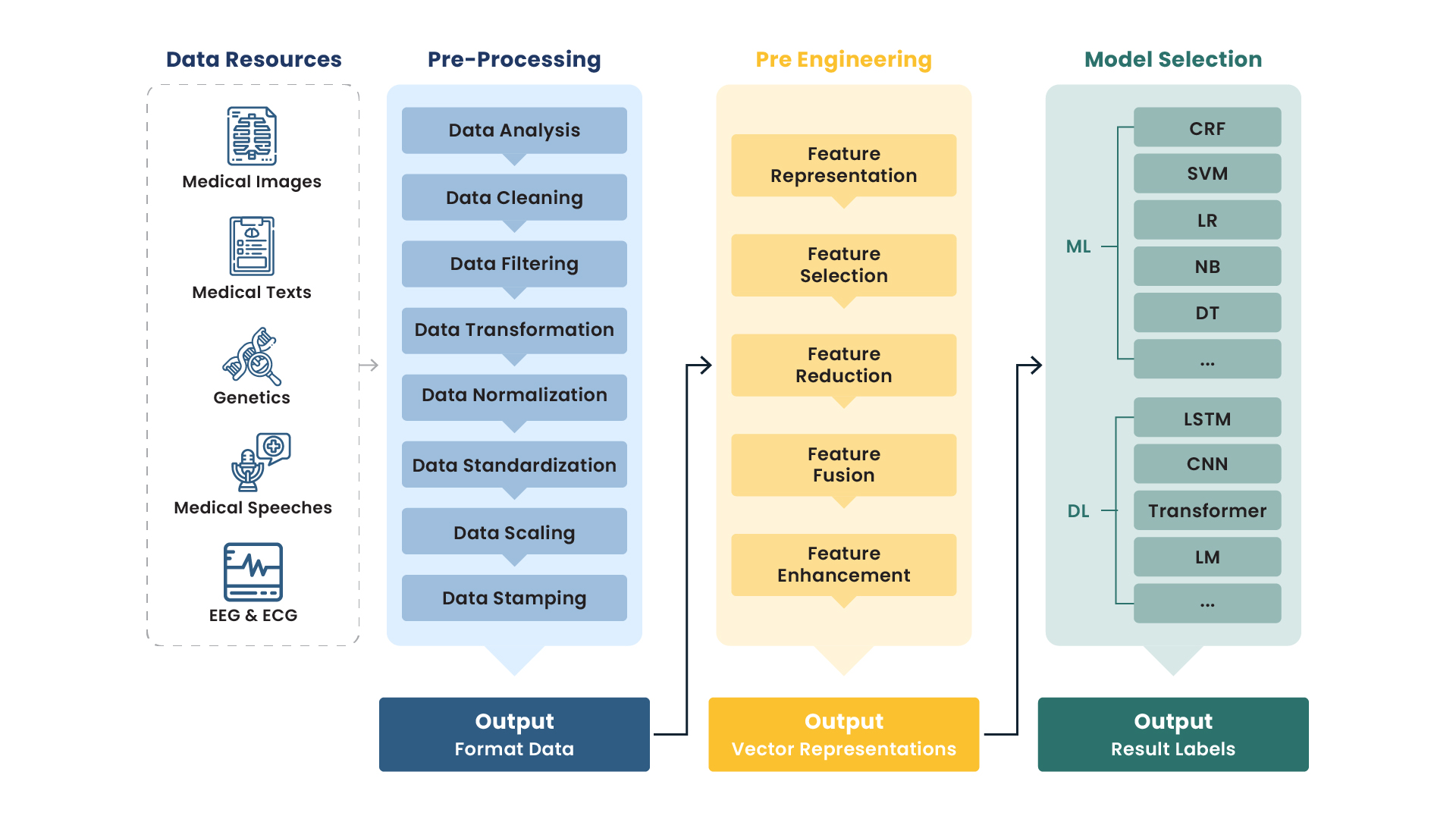
The infographic above shows the flow of the process in considerable depth, which many of us might not require on a daily basis. Which is why we have done our best to simplify it as much as we could while doing justice to the science behind it.
All one needs to remember to make small talk with an ML engineer is know the following:
The more the data, the better a model will be trained.
The better the quality of data, the better the outputs.
Why is this relevant to us? Because no matter what kind of data you collect, it needs to be as distinct as possible and be accessible in bulk. Now, let’s say you manage to collect varying data of medical images while ensuring both quality and quantity, one cannot simply feed it into a program and expect it to function autonomously. Computers, unlike humans, can’t “see” things. Thus those pictures would need to be converted into something a computer can understand, i.e. data.
The next two blocks in the diagram help with this very problem. Data preprocessing can be simply understood as analysing what the data represents, removing any duplicates or inconsistencies (a process called data cleaning), improving its clarity, and transforming it to be compatible with the model (data transformation). If training a model is equivalent to making food then data preprocessing is gathering all the ingredients, ensuring they haven’t gone bad and chopping them to an appropriate size. Just as a chef follows a recipe rather than tossing ingredients haphazardly into a pan, so too must we meticulously prepare our components.
This is where feature engineering comes into play. The idea is to take our transformed data and learn patterns from it, reduce its size to make training more efficient, and so on. The most important part of this process is Feature Representation. Let’s say you want to train a model to identify a heart in medical images. You will need to supply it with pictures of various organs and label them (e.g., ‘heart’, ‘lung’, ‘liver’). Then, you’ll need to convert each picture into numbers that a computer can understand.
This conversion process, where you decide how the image information will be numerically encoded, is Feature Representation. You could represent each picture by its individual pixel values – essentially, a grid of numbers where each number corresponds to the color/intensity of a tiny dot in the image. Alternatively, and often more effectively, you can focus on abstracting features like textures and edges. While modern AI models learn highly complex visual patterns automatically, these fundamental elements like edges often play a crucial role in defining the distinct shapes and boundaries of objects, which helps the model to recognize them effectively.
The final block represents the models that can be selected. There is no ‘one size fits all’ model; each has its own strengths and weaknesses. It is often dependent on the context that a certain model is chosen. This article will not delve into the intricacies of each model mentioned, nor the numerous others that exist, but it is important to understand the major differences between Machine Learning (ML) and Deep Learning (DL).
A crucial distinction between the two is captured perfectly with the following quote, ‘All DL models are ML models, but not all ML models are DL models.’ In other words, DL is a subset of ML that uses ‘neurons’ to simulate the working of our brains. DL is much more resource intensive in terms of computation power and data required to train the model satisfactorily. These models are also difficult to interpret owing to their ‘black box’ nature.
This nature of the DL Neural Networks is due to many neurons being connected to each other in layers. These layers, and the connections within them, involve millions or even billions of parameters (the weights and biases that define the strength of connections). This vast number of parameters and complex interconnections makes reasoning of a certain output very difficult to track. In contrast, ML models are simpler to understand as their logic for giving a certain output is based on more transparent algorithms whose workings are more easily inspectable by the engineer or data scientist.
Pillars of Machine Learning in Healthcare
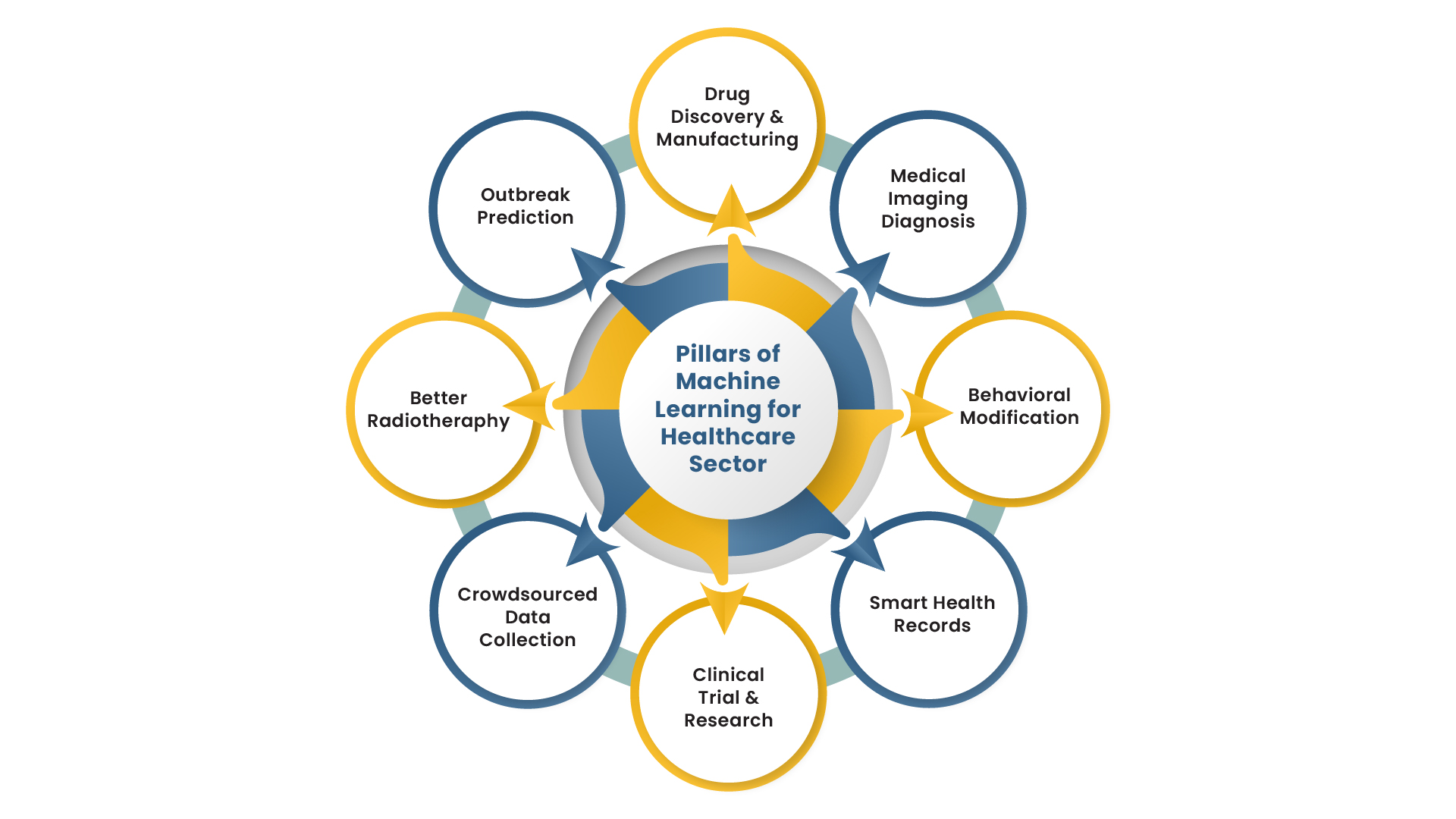
ML in healthcare is built on several foundational pillars:
- Outbreak Prediction: Enables early detection of disease outbreaks. ML models predicted COVID-19 hotspots with 85% accuracy (EIT Health).
- Medical Imaging Diagnosis: Enhances accuracy in image analysis. ML detects anomalies in X-rays and MRIs with high precision.
- Behavioral Modification: Promotes healthier lifestyles through personalized interventions.
- Smart Health Records: Manages patient data intelligently. ML extracts actionable insights from EMRs.
- Better Radiotherapy: Improves precision in radiation treatments. ML optimizes treatment plans.
- Crowdsourced Data Collection: Leverages community data for real-time insights. Platforms like Kaggle have used crowdsourced data for health analytics.
- Clinical Trial and Research: Optimizes trial design. ML identifies ideal participants and analyzes results.
- Drug Discovery and Manufacturing: Accelerates drug development. ML reduces discovery timelines by up to 30%.
Multimodal Data in Machine Learning
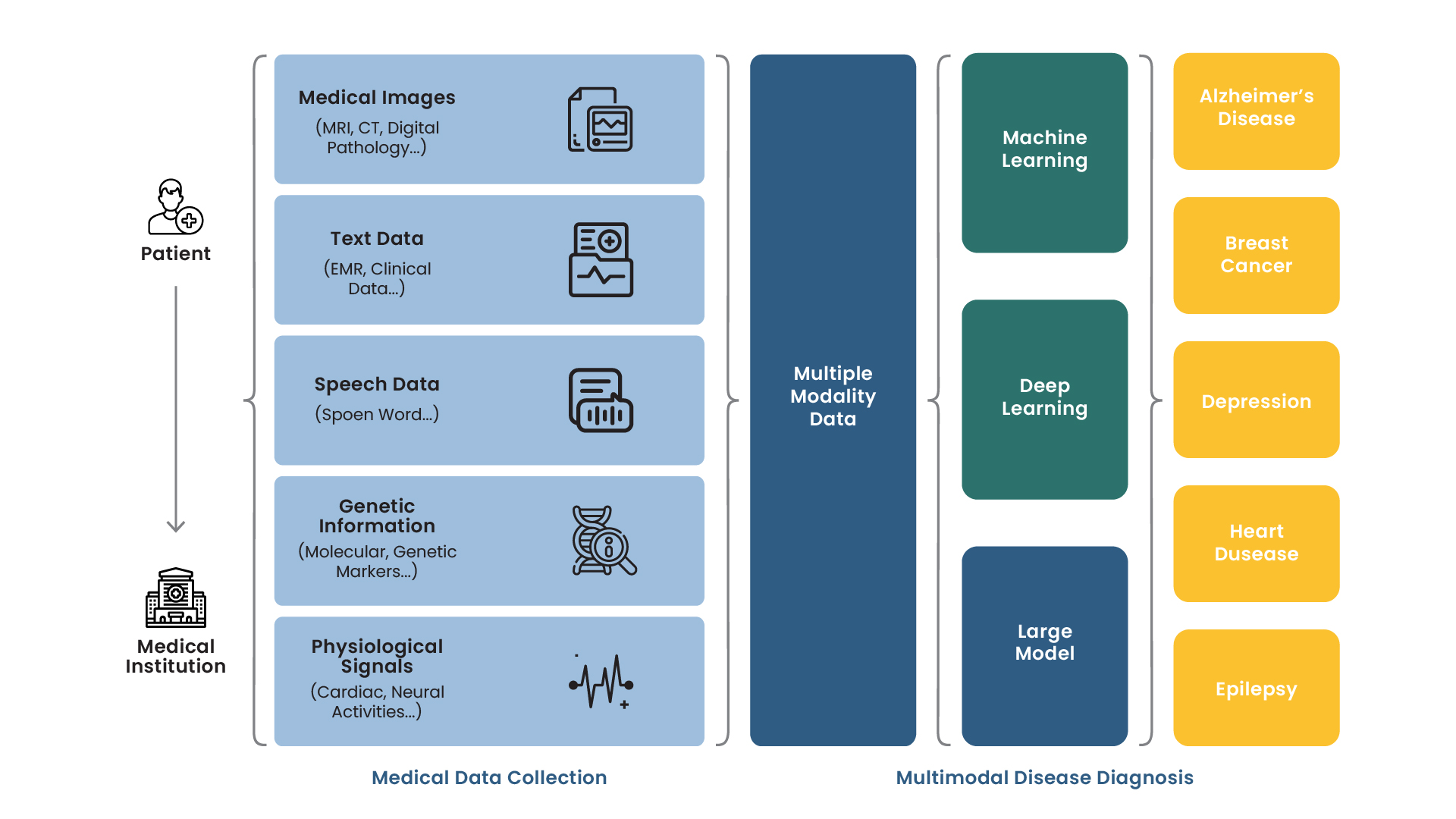
ML leverages diverse data types to enhance diagnostics:
- Medical Imaging: Uses CT, MRI, and digital pathology for anomaly detection. Deep learning models like CNNs excel in spatial feature extraction.
- Text Data: Analyzes EMRs and clinical notes for contextual insights using NLP.
- Speech Data: Captures patient experiences through tone analysis, detecting conditions like depression.
- Genetic Data: Identifies molecular predispositions for personalized diagnostics.
- Physiological Signals: Monitors cardiac and neural activity for real-time assessments.
- Machine Learning: Uses techniques like SVMs and RFs for automated diagnostics.
- Deep Learning: Employs CNNs and RNNs for tumor detection and disease monitoring.
- Large Models: Capture complex patterns from vast datasets for advanced diagnostics.
Features of Machine Learning in Healthcare
ML offers a range of features transforming healthcare delivery:
- AI Tools: Support advanced diagnostics and decision-making. For example, Insitro uses ML to build predictive models for drug development (Built In).
- Cloud Data Systems: Provide secure, scalable storage. Cloud-based systems handle large datasets for ML applications.
- Fitbits and Smart Watches:Enable real-time monitoring. Wearables collect data analyzed by ML for timely interventions (KMS Healthcare).
- Smart Care: Delivers personalized care. ML tailors treatment plans based on patient data.
- EMRs: Enhance record-keeping. ML analyzes EMRs to predict diseases (ForeSee Medical).
- Digital Discharge Notes: Streamline patient releases. ML automates documentation to reduce administrative burdens.
- Smart Reports: Enable rapid data analysis. ML processes datasets for quick insights.
- Support Documents: Provide tailored resources. ML generates patient-specific educational materials.
- Reduced Costs: Optimize processes. ML automation lowers healthcare expenses.
Conclusion
Machine learning and AI, once a futuristic concept, is a present-day catalyst reshaping healthcare at every level. From predicting outbreaks and enhancing diagnostics to optimizing treatment plans and accelerating drug discovery, ML is augmenting the capabilities of healthcare professionals and improving patient outcomes across the globe.
What makes this transformation so powerful is ML’s ability to harness vast, diverse datasets – medical images, genetic sequences, clinical notes, even wearable sensor data, and translate them into actionable insights. As these tools evolve, they promise not only greater efficiency and accuracy but also more personalized, preventive care.
However, the true potential of ML in healthcare will only be realized if innovation is matched with ethical responsibility, patient-centric design, and equitable access. As we embrace this digital revolution, the focus must remain on enhancing human care, not replacing it.
The future of medicine isn’t just high-tech – it’s smarter, faster, and more compassionate. And machine learning is helping lead the way.
Insights That Drive Impact
Healthcare is evolving faster than ever — and those who adapt are the ones who will lead the change.
Stay ahead of the curve with our in-depth insights, expert perspectives, and a strategic lens on what’s next for the industry.
